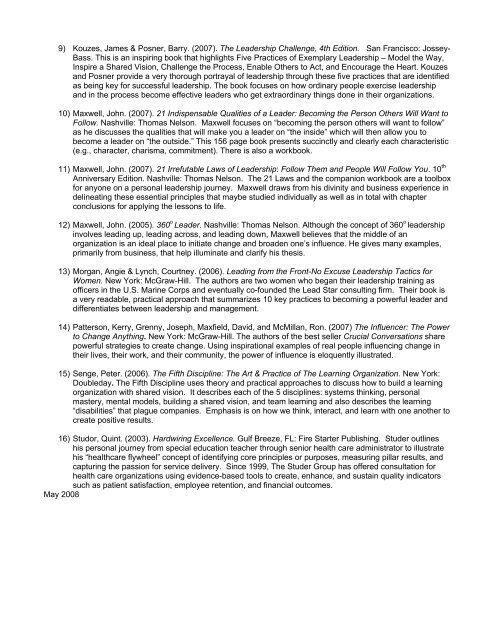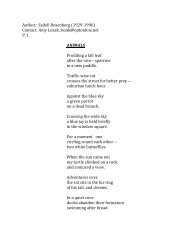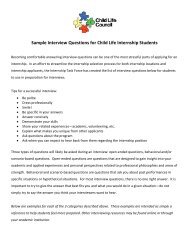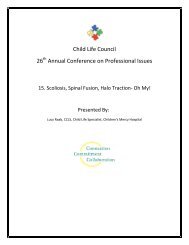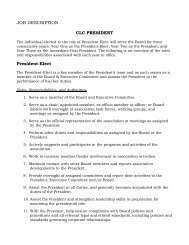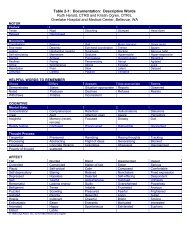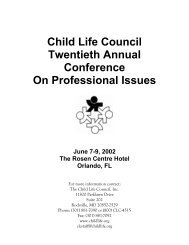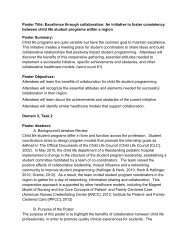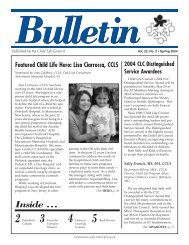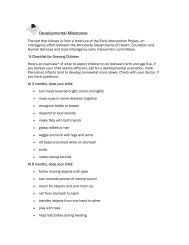The Leadership Journey: Chart Your Course - Child Life Council
The Leadership Journey: Chart Your Course - Child Life Council
The Leadership Journey: Chart Your Course - Child Life Council
You also want an ePaper? Increase the reach of your titles
YUMPU automatically turns print PDFs into web optimized ePapers that Google loves.
9) Kouzes, James & Posner, Barry. (2007). <strong>The</strong> <strong>Leadership</strong> Challenge, 4th Edition. San Francisco: Jossey-Bass. This is an inspiring book that highlights Five Practices of Exemplary <strong>Leadership</strong> – Model the Way,Inspire a Shared Vision, Challenge the Process, Enable Others to Act, and Encourage the Heart. Kouzesand Posner provide a very thorough portrayal of leadership through these five practices that are identifiedas being key for successful leadership. <strong>The</strong> book focuses on how ordinary people exercise leadershipand in the process become effective leaders who get extraordinary things done in their organizations.10) Maxwell, John. (2007). 21 Indispensable Qualities of a Leader: Becoming the Person Others Will Want toFollow. Nashville: Thomas Nelson. Maxwell focuses on “becoming the person others will want to follow”as he discusses the qualities that will make you a leader on “the inside” which will then allow you tobecome a leader on “the outside.” This 156 page book presents succinctly and clearly each characteristic(e.g., character, charisma, commitment). <strong>The</strong>re is also a workbook.11) Maxwell, John. (2007). 21 Irrefutable Laws of <strong>Leadership</strong>: Follow <strong>The</strong>m and People Will Follow You. 10 thAnniversary Edition. Nashville: Thomas Nelson. <strong>The</strong> 21 Laws and the companion workbook are a toolboxfor anyone on a personal leadership journey. Maxwell draws from his divinity and business experience indelineating these essential principles that maybe studied individually as well as in total with chapterconclusions for applying the lessons to life.12) Maxwell, John. (2005). 360 o Leader. Nashville: Thomas Nelson. Although the concept of 360 o leadershipinvolves leading up, leading across, and leading down, Maxwell believes that the middle of anorganization is an ideal place to initiate change and broaden one’s influence. He gives many examples,primarily from business, that help illuminate and clarify his thesis.13) Morgan, Angie & Lynch, Courtney. (2006). Leading from the Front-No Excuse <strong>Leadership</strong> Tactics forWomen. New York: McGraw-Hill. <strong>The</strong> authors are two women who began their leadership training asofficers in the U.S. Marine Corps and eventually co-founded the Lead Star consulting firm. <strong>The</strong>ir book isa very readable, practical approach that summarizes 10 key practices to becoming a powerful leader anddifferentiates between leadership and management.14) Patterson, Kerry, Grenny, Joseph, Maxfield, David, and McMillan, Ron. (2007) <strong>The</strong> Influencer: <strong>The</strong> Powerto Change Anything. New York: McGraw-Hill. <strong>The</strong> authors of the best seller Crucial Conversations sharepowerful strategies to create change. Using inspirational examples of real people influencing change intheir lives, their work, and their community, the power of influence is eloquently illustrated.15) Senge, Peter. (2006). <strong>The</strong> Fifth Discipline: <strong>The</strong> Art & Practice of <strong>The</strong> Learning Organization. New York:Doubleday. <strong>The</strong> Fifth Discipline uses theory and practical approaches to discuss how to build a learningorganization with shared vision. It describes each of the 5 disciplines: systems thinking, personalmastery, mental models, building a shared vision, and team learning and also describes the learning“disabilities” that plague companies. Emphasis is on how we think, interact, and learn with one another tocreate positive results.16) Studor, Quint. (2003). Hardwiring Excellence. Gulf Breeze, FL: Fire Starter Publishing. Studer outlineshis personal journey from special education teacher through senior health care administrator to illustratehis “healthcare flywheel” concept of identifying core principles or purposes, measuring pillar results, andcapturing the passion for service delivery. Since 1999, <strong>The</strong> Studer Group has offered consultation forhealth care organizations using evidence-based tools to create, enhance, and sustain quality indicatorssuch as patient satisfaction, employee retention, and financial outcomes.May 2008


